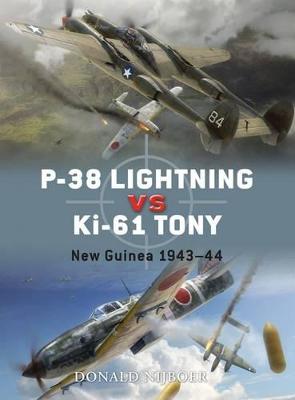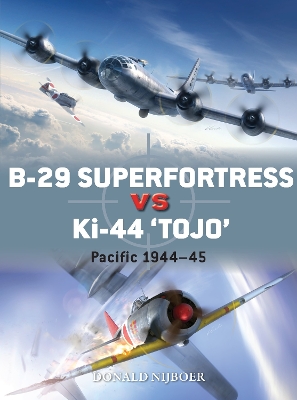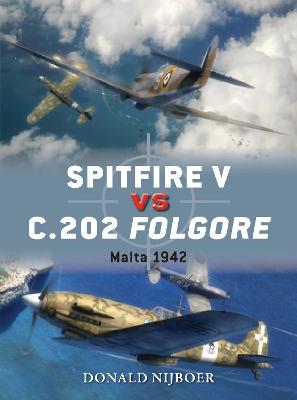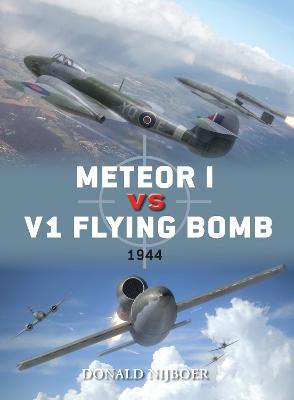Duel
3 primary works • 6 total works
Book 26
With its distinctive, twin-tailed design, the P-38 was one of the most recognizable fighter aircraft of World War II. It was also one of the best. The perfect balance of speed, firepower and range, it made a formable opponent during the crucial battles for the Solomon Islands and New Guinea. In response, the Japanese worked with the Germans to develop the Ki-61, a heavy air superiority fighter with an impressive array of firepower. In head-to-head match-ups, the P-38 proved the superior fighter, but individual duels often came down to the ability and experience of the individual pilots. This book recreates these fast, deadly duels in the skies of the Pacific using dramatic artwork and first-hand accounts.
Book 82
By the time the Americans began their aerial bombardment of Japan in 1944, both the JAAF and IJNAF were spent forces. What the Japanese did have though was the Ki-44 "Tojo". Armed with two 40 mm cannon, it was the most heavily armed and feared single-seat fighter to see action against the new American bomber, the B-29 Superfortress. For the bomber crews, they had what they believed was their 'ace in hole': a fully armed B-29 carried four remotely operated gun turrets and a tail gunner's position, making it the world's most advanced self-defending bomber.
In every respect the Ki-44 pilots were fighting a desperate battle. Many who made their mark did so using suicidal ramming attacks or "taiatari". Illustrated with full colour artwork, this volume examines why the Ki-44 was unable to break up bomber formations conventionally during the Pacific War, and how its ramming tactics, while terrifying, graphically revealed Japan's inability to stop the B-29.
In every respect the Ki-44 pilots were fighting a desperate battle. Many who made their mark did so using suicidal ramming attacks or "taiatari". Illustrated with full colour artwork, this volume examines why the Ki-44 was unable to break up bomber formations conventionally during the Pacific War, and how its ramming tactics, while terrifying, graphically revealed Japan's inability to stop the B-29.
Book 98
Since the end of World War II, the strategic bombing of Germany has inspired numerous studies, countless books and several documentary films, and it is not surprising. With more than one million tons of bombs dropped, close to 300,000 civilians killed, 700,000 wounded and in excess of 3,500,000 industrial and residential structures destroyed, the Allied bomber offensive was industrial war on a grand scale. The air battle that raged over Germany has often been described as a battle between Allied and German fighters but what has been frequently missed by historians on all sides is the impact of German anti-aircraft defences (flak). Though often dismissed as ineffective and a waste of valuable material and personnel, the German flak arm made a major contribution to the defence of the Third Reich - at least half of the American aircraft shot down over Germany fell to flak, and according to the RAF Official History, it was estimated that flak accounted for 1229 of 3302 aircraft lost by Bomber Command between 1942 and April 1945. Additionally, the strategic role of flak extended beyond simply shooting down aircraft - its other, more important task was to force bombers to drop their ordnance sooner or from a higher altitude, thus reducing bombing accuracy.
Both these roles are explored in depth in this detailed study of the German flak defences and of their adversaries, the Allied heavy bombers. Containing full-colour illustrations including cockpit scenes and armament views, this is the definitive guide to the much-overlooked conflict between Allied planes and German anti-aircraft defences.
Both these roles are explored in depth in this detailed study of the German flak defences and of their adversaries, the Allied heavy bombers. Containing full-colour illustrations including cockpit scenes and armament views, this is the definitive guide to the much-overlooked conflict between Allied planes and German anti-aircraft defences.
The inability of the Italians and Germans to invade Malta proved decisive for Allied victory in the Mediterranean during World War II, as the islands provided the Allies with a base from which to project air power. Early Italian efforts to pound the islands into submission were supplemented by major German forces from January 1942 and in a few weeks the situation for the defenders reached a critical stage; in response, in March 1942 the first Spitfires were delivered to Malta. Throughout the summer C.202s fought over Malta, escorting tiny formations of Cant Z.1007s, SM.79s and Ju 88s. The fighting subsided in August and September, but grew in strength with the arrival of more C.202s. In October the Regia Aeronautica could muster three Gruppi with a total of 74 C.202s. For ten days the Italians pressed a relentless attack before attrition brought the offensive to a halt. Throughout the bombing campaign the British were able to supply Malta with ever increasing numbers of Spitfires.
A total of 10,500 missiles were launched as part of the V1 attack, of which 3,957 were destroyed by the defences. Indeed, it could have been much worse, for by the end of the war the Germans had manufactured close to 32,000 flying bombs. The defences put forward to guard against the V1 were formidable - 23,000 men and women with their guns, radar and communications networks were installed on coastal sites. Squadrons of Britain's newest Spitfires, the F XIVs, and Hawker Tempest Vs were kept at home to battle the new menace. Rushed into action in July 1944 to help counter the V1 threat, Britain's Gloster Meteor I was the first jet fighter to enter RAF service. On 4 August the Meteor scored its first V1 victory. Having just closed in on a flying bomb, its officer squeezed the trigger but his guns jammed. Using the Meteor's superior speed, he was able to overtake the missile and, using his wing tip, he tipped the craft over and sent it crashing into the ground. The interceptions between the V1 and Britain's Gloster Meteor were historic, and ushered in a new era of aerial combat.
The SBD Dauntless dive-bomber was a key cog in the US Navy's aerial arsenal throughout the Pacific War. Although a product of aviation design in the mid to late 1930s, the type soldiered on even as more advanced aircraft were appearing from American factories as the war progressed. Despite its classification as a dive-bomber and rather dated appearance, the SBD Dauntless could more than handle its own against the feared A6M Zero-sen - a regular opponent, especially during the first 18 months of the campaign in the Pacific. The SBD was credited with 138 victories in aerial combat (principally in 1942), 107 of which were fighters and the rest bombers. Seven SBD units claimed five or more aerial victories, with future ace Lt(jg) John Leppla of VS-2 being credited with four victories while flying from the carrier USS Lexington during the Battle of the Coral Sea in May 1942. The Zero-sen came to symbolise Japan's military prowess during the early stages of the war in the Pacific, and it quickly became the world's premier carrier-based fighter - a title it would hold well into 1943. The psychological impact of the Zero-sen was so great that all Allied fighters were judged by the standards set by it. The aviators flying the A6M in 1941-42 were amongst the most experienced fighter pilots in the world, and they claimed a significant number of the SBDs destroyed while trying to defend their carriers from attack during the Battles of Coral Sea, Midway and Santa Cruz in 1942. While one was a dive-bomber and the other a nimble fighter, both met in combat many times, with the Dauntless proving an elusive and deadly target thanks to the tenacity and skill of the pilots and gunners manning the Douglas aircraft. While the Zero-sen was credited with shooting down many SBDs, the rugged dive-bomber gave as good as it got and emerged, not surprisingly, victorious on many occasions.
This book examines these aircraft in detail, exploring their history and development and contains accurate descriptions of the combats between the SBD Dauntless and Zero-sen throughout the first four carrier battles of 1942 and the Solomons Campaign.
This book examines these aircraft in detail, exploring their history and development and contains accurate descriptions of the combats between the SBD Dauntless and Zero-sen throughout the first four carrier battles of 1942 and the Solomons Campaign.





